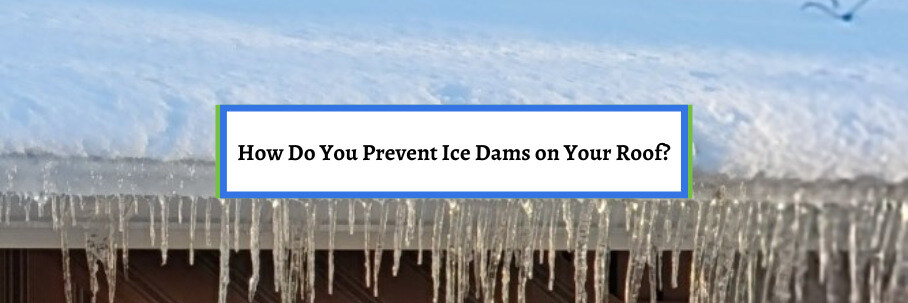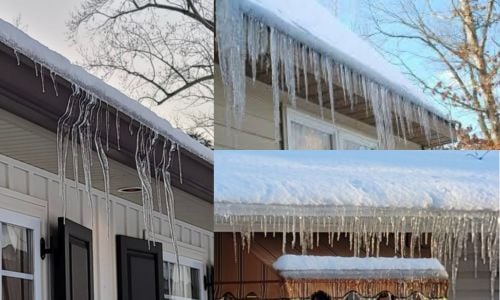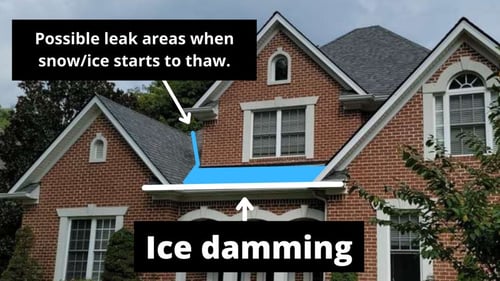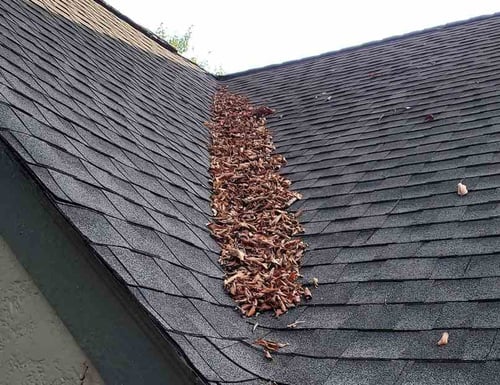How Do You Prevent Ice Dams on Your Roof?

Does your roof leak when there’s snow on it? Are you tired of worrying every time you see snow in the forecast?
I can always guarantee our office will be full of calls for leaks when there’s snow on roofs. And I can also guarantee what the problem is: ice dams.
Ice damming is becoming a bigger and bigger problem in the United States. Unfortunately, most homeowners aren’t equipped or have the knowledge needed to do something about them before they leak.
So, how exactly do you prevent ice dams from forming on your roof?
For over 30 years, Bill Ragan Roofing has guided homeowners through their roof problems with simple information and advice. So, I want to help you understand what you can do about ice damming.
First, you’ll learn what an ice dam is and why it causes a problem. After that, I’ll break down how to prevent ice dams, if you should remove them, and what you can do to prevent ice dam leaks even if they form.
What is an ice dam on a roof?
An ice dam is a blockage of ice that doesn’t allow water to drain once the snow thaws, creating a dam. It occurs on a roof when water freezes down by the gutter line (eaves) and starts backing up the roof.

Ice dams usually start down at the gutter line, but they also form in roof valleys, around a roof cricket, and where a valley comes in against a wall (deadpan valley). But no matter where they form, ice dams block water from draining down your roof.
 (Example of areas where ice dam leaks occur)
(Example of areas where ice dam leaks occur)
Once everything starts thawing, water backs up and eventually finds the path of least resistance until it gets underneath the roofing materials. This creates a continuous drip into your home until it’s warm enough outside for the blockage at the bottom to completely thaw out.
How do you prevent ice dams on your roof?
Preventing ice dams may be difficult based on your area, the climate, and the amount of freezing weather you get. However, you can make the likelihood of ice dams forming less likely by doing a few things.
The best way is to insulate your attic to stop warm air from escaping through the roof. On top of this, ensuring your attic is properly ventilated also helps by expelling warm air and keeping the attic cool to maintain a consistent temperature.
Both things prevent or slow down snow from melting by keeping your roof at the same temperature as outside, which doesn’t give water the chance to back up once it thaws out. While those two are the best, keeping your gutters and roof clear of sitting debris is the easiest way to avoid ice damming.

Sitting debris already creates a dam that stops drainage and makes it even easier for an ice dam to form on top of it. Even worse, this dam doesn’t go away once the ice goes away like a normal ice dam.
Should you remove ice dams from a roof?
Once an ice dam leak starts, some homeowners get on their roofs with a hose, buckets of hot water, shovel, or rake to remove them. However, this is the last thing you should do.
It’s mainly a huge safety risk, but you can also cause extensive damage to your roof and create bigger problems. If you really want to do something about ice damming, you need to use specific roofing tools (such as a roof rake) to remove snow from your roof safely and efficiently.
Now, I’m of the mindset that many of these tools can still cause damage. So, do plenty of research to ensure they’re roofing-specific and won’t cause damage before purchasing anything.
Heat cables can also be installed on your roof to prevent ice dams from forming, but these are more common in areas with frequent snow and ice build-up. Just know this can cause other issues and a potential fire hazard.
What can you do to avoid leaks when there’s ice damming on your roof?
There’s nothing you can do to stop leaks caused by ice damming when it’s already happening. However, there are things you can install when getting a new roof to prevent ice dam leaks.

The best thing to do is install ice and water shield in areas where ice dams commonly build up, like roof valleys and against walls. This creates an extra waterproof barrier that helps prevent water from getting into your home if it gets under the roofing material.
For deadpan valleys, you need something stronger (metal or a membrane material) installed in the valley and/or against the wall to prevent water from seeping into cracks. But remember, ice damming first starts down at the gutter line.
.jpg?width=500&height=423&name=IceandWaterShieldUpgrade%20(2).jpg)
To prevent leaks down your walls, you’ll need to install ice and water shield around the roof edges (rakes and eaves) that go 2 feet past the interior walls of your home. This is a huge and expensive upgrade in places, like where we are in Tennessee.
However, some areas in the United States actually require this per local codes if ice damming and frequent snowy weather is a common occurrence.
How else do snow and ice impact your roof?
After reading this article, you know what causes ice dams, how to prevent them, if you should remove them, and what to do to avoid leaks. Remember, there’s nothing you can really do to stop an ice dam leak once it starts.
You can try to remove the ice altogether, but that comes with major risks. Your best option is to install the right things in the right areas and make sure your attic is properly ventilated if ice damming is a frequent problem.
Unfortunately, ice damming isn’t the only thing to worry about. While it’s the main one, there are other roof problems that come with snow and ice.
That’s why I wrote another article breaking down how else snow and ice can impact your roof.
Check out How Does Snow and Ice Impact Your Roof to learn the other things to watch for when there’s sitting snow on your roof.


